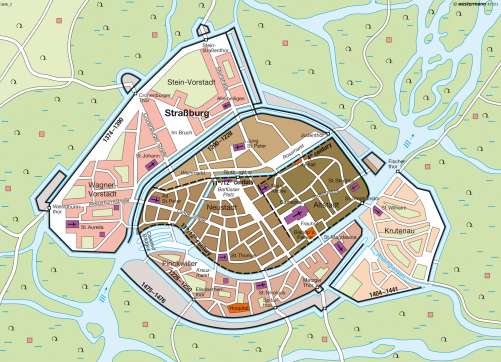Strasbourg -- medieval
[[]]
Quote
Appearance
Climate
Economy
Geography
Strasbourg is known for its cathedral, which displays a predominantly Gothic face in its present form. Yet the city's history began much earlier. The traces of the oldest settlement are concentrated largely in the historical city center on the Grande Île (Grand Island), which is encircled by two arms of the River Ill. The Old City was declared a World Cultural Heritage site in 1988.
Roman times
Strasbourg's roots can be traced to the year 12 BC, when the Roman General Nero Claudius Drusus established a military outpost called the Argentoratum. The importance of the site at the point where the Ill and the Rhine converge was later enhanced by a road built between Augsburg and Mainz. The orthogonal layout of streets was typical of Roman settlements and featured a main crossroads. This pattern is still recognizable today in the alignment of Rue du Dôme and the Rue des Hallebardes, which intersect north of the cathedral. The military camp and the civilian settlements that came later could no longer be maintained after the fall of the Limes in the 4th century and were abandoned in the 5th century. Most of the ruins from the period of Roman settlement were not discovered until after the Second World War. These include the remnants of a temple and a theatre.
The medieval city
The medieval city of Strasbourg developed from settlements founded by the Alemanni and the Franks. The city developed on terrain that had been identified as excellent building land long before: the island in the River Ill. Strasbourg was incorporated into the Frankish Empire as Strateburgum in 496. In the 9th century, it became part of the emerging medieval German Empire. Until 1200, the development was limited to the island, which was covered with a grid of narrow streets and lanes. The largest open space is identifiable in the north-western quadrant of the map – the Place Kléber, which still plays an important role in the life of the city today. Equally important were the churches, for Strasbourg had already become the seat of the Bishopric of Strasbourg in the 4th century. The most striking example of church architecture is the cathedral. Construction began at the site of several earlier structures in 1176 and was not completed until 1439. Strasbourg acquired the title of Free Imperial City in the 14th century. The economy flourished. This was also the period during which the original medieval city was expanded. Building had already begun in the South in 1228; the first new buildings in the North-west were erected in 1374 and in the South-west in 1387. The Rhine Bridge was built a year later.
History
Roman Control
The Romans under Nero Claudius Drusus established a military outpost belonging to the Germania Superior Roman province close to a Gaulish village near the banks of the Rhine, at the current location of Strasbourg, and named it Argentoratum. Its name was first mentioned in 12 BC but "Argentorate" is the toponym of the Gaulish settlement that preceded it before being latinised, though it is not known by how long.
From 90 AD the Legio VIII Augusta permanently stationed in Argentoratum. The Roman camp of Argentoratum then included a cavalry section and covered an area of approximately 20 hectares (49 acres), from approximately 6 hectares (15 acres) in Tiberian times. Other Roman legions temporarily stationed in Argentoratum were the Legio XIV Gemina and the Legio XXI Rapax, the latter during the reign of Nero. Brick bearing the stamp of the Legio VIII Augusta, found in Rue du Dôme (Musée historique de Strasbourg)
The Alemanni fought a Battle of Argentoratum against Rome in 357 AD. They were defeated by Julian, later Emperor of Rome, and their king Chnodomar was taken prisoner. On 2 January 366 the Alemanni crossed the frozen Rhine in large numbers, to invade the Roman Empire.
From the 4th century, Strasbourg was the seat of the Bishopric of Strasbourg (made an Archbishopric in 1988).
Early in the 5th century the Alemanni appear to have crossed the Rhine, conquered, and then settled what is today Alsace and a large part of Switzerland. From this period on Argentoratum disappears from historical records and is replaced by the toponym "Stratisburgum".
After the Romans
Between 362 and 1262, Strasbourg was governed by the bishops of Strasbourg; their rule was reinforced in 873 and then more in 982. In 1262, the citizens violently rebelled against the bishop's rule (Battle of Hausbergen) and Strasbourg became a free imperial city.
Current Events
Population
- -- City () - Imperial Census 1094 A.D.
Citizens of Nürnberg
Clergy
Craftsmen
Indentured Servants
Patricinate
Slaves
Visitors
Council of Merchants
Brothels
Cemeteries
Fortifications
[[]]
Holy Ground
Churches
Convents
Inns
Law & Lawlessness
Monuments
Private Residences
Taverns
Supernatural Strasbourg
Fae of Strasbourg
Mages of Strasbourg
Arcane Objects of Strasbourg
Vampires of Strasbourg
Günther: The Prince
Appearance:
Behavior:
History:
Recent Events:
Günther's Brood
'
- Giselmund -- Eldest of Günther's Brood, he serves as his sire's advisor. -- Großvater
- Adalbert -- Second progeny and Günther's confessor, primarily he listens to his sire and on occasion hands out punishment as requested. -- Vater
- Frida -- Third progeny, daughter, lover and caretaker, she fills every female role that Günther might need. -- Mutter
- Anselm -- Fourth progeny and Günther's bodyguard, he goes everywhere with his sire and would die for Günther in an instant. -- Ritter
- Otmar -- Fifth progeny and Günther's seneschal, he works hard to find revenue for Günther's needs and unfortunately for those of Willahelm as well. -- Kastellan
- Hildiberht -- Sixth progeny and rebellious blacksheep, the hellion of Günther's progeny, he lives to bedevil both his sire and siblings. -- Teufel
- Willahelm -- Seventh progeny and prodigal son, he is Günther's youngest and most beloved son, he is a good for nothing wastrel. -- Prasser
Maeghar the Kiasyd
[[]]
Werewolves of Strasbourg
Wraiths of Strasbourg
Websites


